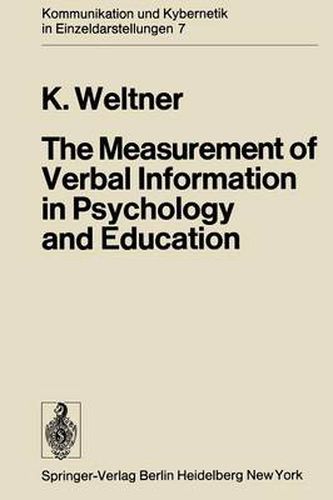Readings Newsletter
Become a Readings Member to make your shopping experience even easier.
Sign in or sign up for free!
You’re not far away from qualifying for FREE standard shipping within Australia
You’ve qualified for FREE standard shipping within Australia
The cart is loading…






This title is printed to order. This book may have been self-published. If so, we cannot guarantee the quality of the content. In the main most books will have gone through the editing process however some may not. We therefore suggest that you be aware of this before ordering this book. If in doubt check either the author or publisher’s details as we are unable to accept any returns unless they are faulty. Please contact us if you have any questions.
Information theory and cybernetics have developed along somewhat different lines in Europe and in the U. S. A. This book is to be seen as a contribution towards bridging the gap. Anyone who seeks to apply information theory in the fields of education and psychology very soon comes up against a central diffi culty: in the form in which it was developed by Shannon information theory excludes the semantic aspect. This problem is fundamental for in education, as in psychology, the semantic aspect is the very heart of the matter. Thus, while Attneave, Miller and Quastler, among others, successfully employed the concepts and units of measurement of in formation theory in the interpretation of the findings of experimental psychology, they were obliged to restrict their work to its syntactic and statistical aspects. Before we can make use of the methods and results of information we have to solve the central problem: How can theory in actual teaching, we measure the semantic information of a verbal message? The only way to do this is by extending the theory. A special concept has been deve loped for this purpose: subjective information. In place of an objectively measurable quantity (frequency of sign sequences) we set an empirically determined one: the subjective probability with which the recipient expects a certain sign sequence.
$9.00 standard shipping within Australia
FREE standard shipping within Australia for orders over $100.00
Express & International shipping calculated at checkout
This title is printed to order. This book may have been self-published. If so, we cannot guarantee the quality of the content. In the main most books will have gone through the editing process however some may not. We therefore suggest that you be aware of this before ordering this book. If in doubt check either the author or publisher’s details as we are unable to accept any returns unless they are faulty. Please contact us if you have any questions.
Information theory and cybernetics have developed along somewhat different lines in Europe and in the U. S. A. This book is to be seen as a contribution towards bridging the gap. Anyone who seeks to apply information theory in the fields of education and psychology very soon comes up against a central diffi culty: in the form in which it was developed by Shannon information theory excludes the semantic aspect. This problem is fundamental for in education, as in psychology, the semantic aspect is the very heart of the matter. Thus, while Attneave, Miller and Quastler, among others, successfully employed the concepts and units of measurement of in formation theory in the interpretation of the findings of experimental psychology, they were obliged to restrict their work to its syntactic and statistical aspects. Before we can make use of the methods and results of information we have to solve the central problem: How can theory in actual teaching, we measure the semantic information of a verbal message? The only way to do this is by extending the theory. A special concept has been deve loped for this purpose: subjective information. In place of an objectively measurable quantity (frequency of sign sequences) we set an empirically determined one: the subjective probability with which the recipient expects a certain sign sequence.